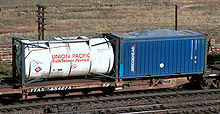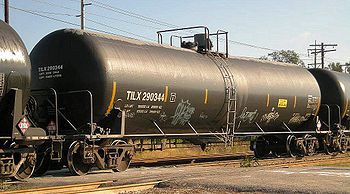- Tank car
-
A tank car (UIC: tank wagon) is a type of railroad (UIC: railway) rolling stock designed to transport liquid and gaseous commodities.
Contents
History
Timeline
- 1865: Flats with banded wooden tanks mounted on top are employed for the first time to transport crude oil from the fields of Pennsylvania during the Pennsylvanian oil rush.
- 1869: Wrought iron tanks (with an approximate capacity of 3,500 US gal or 13 m3 per car) replace wooden tanks.
- 1888: Tank car manufacturers sell units directly to the oil companies, with capacities ranging from 6,000–10,000 US gal (23–38 m3).
- 1903: Tank car companies develop construction safety standards. More than 10,000 tank cars are in operation.
- 1915: A classification system is developed by the tank car industry to ensure the correct match of product being shipped to car type. Some 50,000 tank cars are in use.
- 1920: Welding replaces riveting in tank car construction, enhancing the safety of cars.
- 1930: 140,000 tank cars transport some 103 commodities.
- 1940s: Virtually every tank car is engaged in oil transport in support of the war effort.
- 1950: Pipelines and tank trucks begin to compete for liquid transport business.
- 1963: The Union Tank Car Company (UTLX) introduces the "Whale Belly" tank car.
Usage
Many variants exist due to the wide variety of liquids and gases transported. Tank cars can be pressurized or non-pressurized, insulated or non-insulated, and designed for single or multiple commodities. Non-pressurized cars have various fittings on the top and may have fittings on the bottom. Some of the top fittings are covered by a protective housing. Pressurized cars have a pressure plate, with all fittings, and a cylindrical protective housing at the top. Loading and unloading are done through the protective housing.
Tank cars are specialized pieces of equipment. As an example, the interior of the car may be lined with a material, such as glass, or other specialized coatings to isolate the tank contents from the tank shell. Care is taken to ensure that tank contents are compatible with tank construction.
As a result of this specialization, tank cars have generally been "one-way" cars. Other cars, like boxcars, can easily be reloaded with other goods for the return trip. Combinations of the two types were attempted, such as boxcars with fluid tanks slung beneath the floors. While the car could certainly carry a load both directions, the limited tank size made this unsuccessful.
A large percentage of tank cars are owned by companies serviced by railroads instead of the railroads themselves. This can be verified by examining the reporting marks on the cars. These marks invariably end in X, meaning that the owner is not a common carrier.
Within the rail industry, tank cars are grouped by their type and not by the cargo carried. Food service tank cars may be lined with stainless steel, glass, or plastic. Tank cars carrying dangerous goods are generally made of different types of steel, depending on the intended cargo and operating pressure. They may also be lined with rubber or coated with specialized coatings for tank protection or product purity purpose. The tank heads are also stronger to prevent ruptures during accidents. The whale belly type is giving way to higher capacity, yet standard-width cars.
All tank cars undergo periodic inspection for damage and corrosion. Pressure relief valves are inspected at every loading. Pressurized cars are pressure-tested regularly to insure the integrity of the tank.
All tank cars operating throughout North America today feature "double shelf" AAR type "F" couplers that prevent disengaging in event of an accident or derailment. This all but eliminates the chance of couplers puncturing adjacent tank cars.
Insulated cars (which may also incorporate heating or refrigeration systems) are used when the contents must be kept at a certain temperature. For example, the Linde tank car depicted below carries liquefied argon. Cars designed for multiple commodities are constructed of two or more tanks (compartments). Each compartment must have separate fittings. The lower capacity and added complexity of multicompartment cars means that they make up a small percentage of the tank car inventory.
Outside of North America, tank cars are also known as tank wagons or tanker wagons.
Specialized applications
Milk cars
Main article: Milk carA milk car is a specialized type of tank car designed to carry raw milk between farms, creameries, and processing plants.
Milk is now commonly chilled before loading, and transported in a glass-lined tank car. Such tank cars are often placarded 'Food service use only'.
Liquid Hydrogen tank car
Main article: Liquid hydrogen tank carTank cars of this type are designed to carry cryogenic liquid Hydrogen (LH2). North American cars are classified as DOT113, AAR204W, and AAR204XT[1]
Pickle cars
A pickle car was a specialized type of tank car designed to carry pickles. This car consisted of several wooden or metal vats (typically three or four) and was often roofed. Pickles which are preserved in salt brine were loaded through hatches in the roof.
Tanktainers
Main article: Liquid hydrogen tanktainerFurther information: Tank chassis Type of shipping containers mounted on a spine car: Tanktainer (left), and an open-top shipping container with canvas cover (right)
Type of shipping containers mounted on a spine car: Tanktainer (left), and an open-top shipping container with canvas cover (right)
A tanktainer, also known as a tank container, is a specialized type of container designed to carry bulk liquids, such as liquid hydrogen, gases and other dangerous goods as well as non dangerous bulk liquids on standard flatcars, well cars or semi-trailers in intermodal freight transport. The tank is held within a box-shaped frame the same size and shape as an intermodal container.
Torpedo cars
A torpedo car or bottle car is a type of railroad car used in steel mills to haul molten pig iron from the blast furnace to begin the process of primary steelmaking.
The thermally-insulated vessel is mounted on trunnions, and designed to endure extremely high temperatures, as well as keeping the metal in a molten state over extended periods of time. The vessel can be pivoted along its longitudinal axis to empty the pig iron into a furnace (such as a basic oxygen furnace) or crucible.
Vinegar cars
A vinegar car is a specialized type of tank car designed to transport vinegar. The largest such car built was built by Morrison Railway Supply Corporation in 1968. The car's underframe included all of modern facets of freight car design including roller bearing trucks and cushioning devices built by FreightMaster, while the tank that rode on it, made of Douglas Fir, had a capacity of 17,100 US gallons (65 m3; 14,200 imp gal). The car, in what has been called 'the largest wooden tank car ever built', took 18 months to build.
Vinegar is now moved in ordinary tank cars lined with glass, plastic, or alloy steel.[2]
"Whale Belly" cars
In the early 1960s, the Union Tank Car Company (UTLX) introduced a series of "whale belly" tank cars which offered increased capacity. These cars carried from 33,000 US gallons (120 m3; 27,000 imp gal) in CSOX #31084[3] to as much as 63,000 US gallons (240 m3; 52,000 imp gal) in GATX #96500, which had been conceived as a 'rolling experiment' of sorts. The largest tank car ever placed into regular service, UTLX #83699, was rated at 50,000 US gallons (190 m3; 42,000 imp gal). It first hit the rails in 1963, remained in service for over twenty years, and is now on display at the Museum of Transportation in Saint Louis, Missouri. This behemoth is 89 feet (27.13 m) in length, weighs 175,000 lb (79,400 kg) empty, and rides on four two-axle trucks to distribute the additional weight. It was used to transport such diverse substances as liquefied petroleum gas (LPG) and anhydrous ammonia.
Safety
Where AAR (Alliance) couplers are fitted, the type "F" coupler is preferred as these are less likely to become separated in a derailment and become a puncture hazard for other tank cars. The type "F" coupler has shelves over and under the coupler that prevent the coupler sliding out of position after a derailment.[citation needed]
In addition, some types of tank cars have a second end plate visible from the exterior to further avoid end punctures.
It is also preferable if the taps are depressed within the body of the tank so as to present a reduced knock-off hazard during a derailment.[citation needed]
See also
References
- ^ NOAA's Office of Response and Restoration: Chemical Response Tool
- ^ "Week at a glance: Vinegar by rail - in giant wooden tanks". Railway Age 165 (17): p 11. October 28 1968.
- ^ CSOX #31084
Sources
- Herron, J. (April 2002). "History Of The Rail Tank Car". e-Train, the online magazine of the Train Collectors Association. http://tcaetrain.org/articles/tickets/tankcar/index.html. Retrieved April 20, 2007.
- White, Jr., John H. (1993). The American Railroad Freight Car. The Johns Hopkins University Press, Baltimore, Maryland. ISBN 0-8018-5236-6.
External links
- Rail Whales
- Modern Tank Car Homepage
- Tank car dictionary
- Milk Trains blog for information specific to milk tank cars.
- Liquid Hydrogen Transport by Rail
- Guide to Railcars
Hydrogen infrastructure Liquid hydrogen Compressed hydrogen Rail transport freight equipment Enclosed equipment Autorack · Boxcar (US) · Coil car · Container · Covered hopper · Covered wagon · Refrigerator car (US) · Refrigerated van (EU) · Roadrailer · Stock car · Tank carOpen equipment Flatcar · Gondola (US) · Hopper car · Open wagon (EU) · Modalohr · Schnabel car · Double-stack car · Mineral wagon · Slate wagonNon-revenue equipment Caboose (US) · Brake van (EU) · Work trains · Scale test car · Clearance car · Crane (railroad) · Rotary snowplowCategories:- Freight equipment
- Rail transport terminology
- Gas technologies
- Hydrogen infrastructure
Wikimedia Foundation. 2010.

